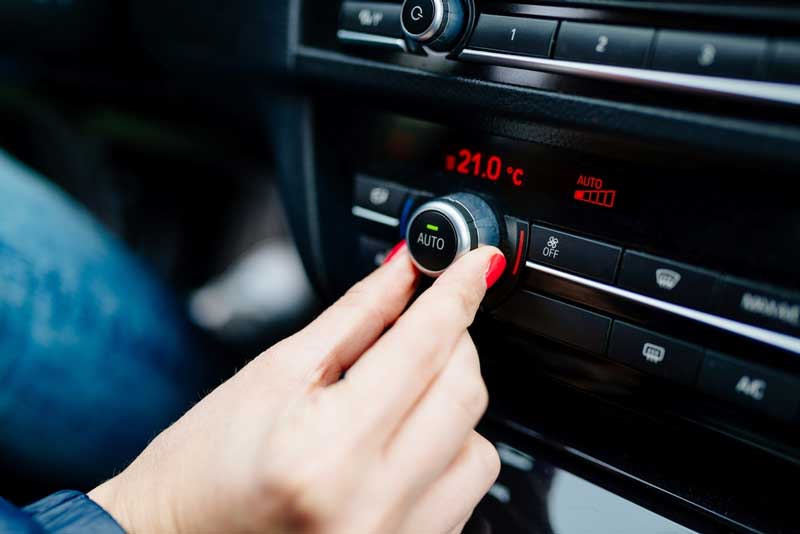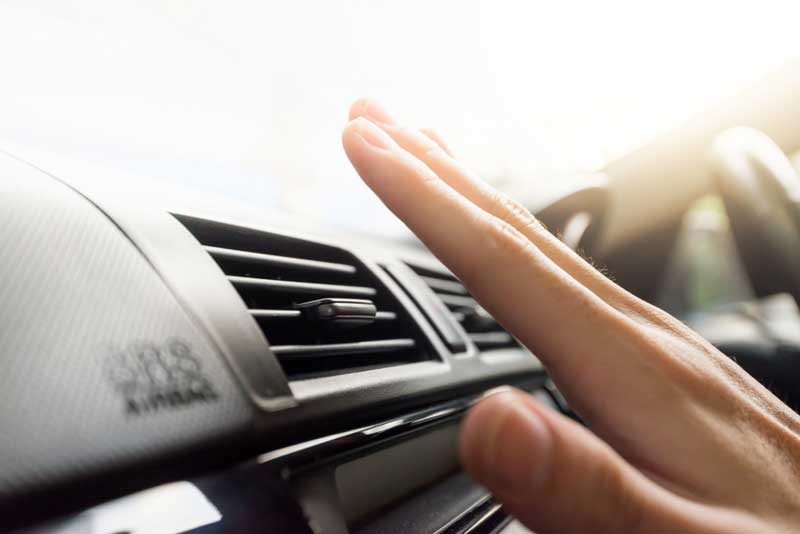Is your car air conditioner blowing hot air? What might cause this problem, and how can it be fixed?
The reasons are not far-fetched, as you will subsequently be informed in this article.
Usually, a vehicle’s AC emits hot air for several reasons, such as problems with the electrical system, a clogged air filter, a faulty condenser, a faulty compressor, and a Refrigerant leak.
In the course of this article, we will discuss how a vehicle’s AC works, why a vehicle’s AC emits hot air, how you can return the AC to cold/cool air, and things to do to prevent the emittance of hot air from your AC, the cost of fixing your AC, and more.
Let’s get started!
Why is Car Air Conditioner Blowing Hot Air
Oftentimes, a car air conditioner blowing hot air is caused by a refrigerant leak. Refrigerant is a liquid that circulates through your car’s air conditioner system, and by expansion and contraction, it removes heat and humidity from the cabin.
During hot summer, one constantly feels like keeping the AC running to eliminate heat and cool off.
Hence if you encounter a time when turning on your AC, and you start feeling hot discomforting air from the AC system. I’m certain you will have a question(s) like “what the deuce? Why am I feeling hot air?”
As we proceed, you will learn the numerous reasons why the AC emits hot air. Also, steps on how you can control the car’s AC will be provided.

Reasons Why Your Car’s AC Emits Hot Air
Here are some reasons why the AC of a car emits hot air:
Refrigerant leakage
Most times, when the AC emits hot air, it results from a refrigerant leak. The refrigerant is seen as a liquid that passes through a vehicle’s AC system, thus contracting and expanding while getting rid of humidity and heat from its cabin. Not one of your AC components functions properly without correct refrigerant levels.
A rusted, punctured evaporator or old hose can cause a leak. You cannot easily notice a leak from the refrigerant. Also, one would hardly spot a puddle of liquid under or in the vehicle. The reason is that, as opposed to vital vehicle fluids and motor oil, it evaporates when antifreeze is exposed to the atmosphere. There are times when you will luckily spot oily residue at a particular leak location.
To spot a refrigerant leak, an expert technician is to put dye into the system for him to trace it. As soon as the source is identified, the pipe is fixed by recharging and brazing your vehicle’s AC for it to blow/emit fresh, cold air again.
Bad Compressor
As you may have guessed, it all begins in your compressor. When the compressor works incorrectly, the other parts of the system will also malfunction. The reason is that, first, the compressor makes the refrigerant move.
AC compressors become faulty because of lack of usage. For example, if one cranks the AC after not using it for a long time, the system can be shocked, leading it to faster wear.
Hence, running your AC for 15 minutes or more within a few weeks is good.
The compressor has multiple moving parts, giving room for replacement other than repairs.
Unfortunately, a replacement will cost about $500 – $700. Luckily, one can increase the AC’s life span by using it often.
Bad condenser
As the AC system has pulled out humidity and heat from the cabin, refrigerant further absorbs them. In addition, the function of a condenser is to ensure the refrigerant remains cool for the cycle to continue. When the condenser fails to do its job, the process mentioned above then breaks down.
A condenser is found at a vehicle’s front, between the radiator and the grate. It makes use of air that flows through the grate for it to aid in cooling. If your condenser is clogged or blocked by debris from the road, air will fail to reach it, prohibiting your refrigerant from cooling properly.
If your condenser is faulty, you can decipher it by looking through your grate. Also, check whether the car ACs problems began after a bumper bump or fender bender, that the condenser may have broken based on impact.
You can slap the condenser in the face by blasting it with hot air when the condenser becomes faulty.
Blocked air filter
Lack of proper maintenance on your HVAC system can make the automobile air filter clogged. Solid impurities are efficiently removed from the air by an air filter. Note that if the filter gets clogged, little air travels around it, letting contaminants and dust buildup in your system.
A small quantity of air that goes through the coils fails to cool to its needed temperature. Air then circulates and exits unconditioned, making your vehicle emit hot air.
When an air filter becomes filled with debris and is clogged, all you have to do; is slap it in its face, using a blast/shot of air that has been pressurized; it is best at 120-150 bar.
Faulty electrical system
Electrical issues can emit hot air from the AC when the entire AC parts are in working order. A blown fuse or frayed wire can prevent a sound air conditioner from functioning properly. Correcting and diagnosing an electrical issue starts with a total visual examination of the vehicle’s wiring and fuse box.
If either problem makes your vehicle emit hot air, take it to the local auto electrician. Ensure that the AC is given an accurate and thorough inspection.
Also Read: Temporary Fix for Crankshaft Position Sensor (Expert Guide)
How to make your A/C colder
Change the cabin air filter
The cabin air filter prevents dirt, pollen, other pollutants, and dust from entering your vehicle through heat vents and AC. When the filter is dirty or clogged, it can block or inhibit air conditioner airflow, making cold air struggle to get to the cabin.
Depending on the car, you can examine and change the filter. Check the owner’s manual to find out more information.
Avoid Parking Under the Sun
An AC head start is by averting heat from building up in the vehicle. For example, vehicles parked in straight sunlight can get to internal temperatures as high as 131 to 172 degrees F when the outside temperatures are 80 to 100 degrees F.
Have security and safety in mind, and do not leave the windows half open or cracked. Park in an area that is shaded.
Provide one when you don’t have an option to park in the shade. Create a windshield sun shade to avert sunlight from direct contact so that your vehicle will not become an oven. Sunshades also safeguard your vehicle’s interior from harmful UV rays, which can lead to cracking and dashboard discoloration.
Upgrade your A/C system
In need of some extremely chill moods in your vehicle? Reggae only gets you kind of far.
If you want your AC to get colder – very fast, here is what you can do: reboot the refrigerant. We are not going to dive into how the vehicle’s AC functions, but know that refrigerant level or low Freon usually leads to a vehicle’s AC that fails to feel enough cold.
Examine the refrigerant level while at home. If you possess a thermometer and AC gauge, they are found at many auto parts shops/stores.
Don’t Change to Max A/C Immediately
The temptation to turn on your AC and switch it to “maximum cool” comes as soon as you enter your vehicle. You should know that blasting an AC out of its gate is not the appropriate way of making it chilly. When you turn your AC to maximum, the vehicle takes air from the car, cools it, and blows it right back inside the cabin.
The real issue is that: the first time one gets into the vehicle, you’ll notice that the air outside is not as hot as that inside. (Recall how the temperature in a vehicle can move up to about 200Â degrees F) You are pressurizing the AC to work extra hard without reason.
Pull air from outside the car to cool things faster to fix things. Don’t turn on the AC at first. On the fan (max level), ensure airflow is programmed to its “Outside” mode.
Therefore, as soon as you have gotten rid of a good amount of humid (hot air) built up in the vehicle, on your AC and turn it to airflow mode, “recirculate.” Then you can switch your AC to maximum cool.

How Does a Car’s Air Conditioning System Operate?
Here, we will, in clear detail, explain how the AC system of a vehicle works. Our explanation will pass through the system’s parts and how they work individually and as a unit to give you the desirable cold air.
Let us begin with:
The Compressor of the Car
It takes low temperature, the low-pressure refrigerant in its gaseous state. Hence compresses it to a high temperature, high-pressure gas.
The Condenser of the Car
It functions as a mini radiator. It takes the high-pressure, high-temperature gas from your compressor, then radiates heat. Hence your refrigerant condenses and converts into a high-pressure, lower-temperature liquid. A pair of cooling fans also blows over your condenser to remove excessive heat from your refrigerant as it is in your lines.
The Receiver/Dryer of the Car
The dryer/receiver removes moisture from your refrigerant as it is in a liquid state. This function is achieved by acting as a filter through desiccant (a substance that absorbs moisture.) Remember that small packet you find in a new pair of shoes or bottle of medication; it is the same thing.
The reason is that moisture has to be gotten rid of from your refrigerant to avoid freezing, which will, in turn, clog your expansion valve. Water possesses a 32 degrees freezing point, whereas refrigerant has a 200 degrees freezing point.
The Expansion Valve/Orifice Tube of the Car
The expansion valve/Orifice tube controls the amount of coolant passing through your system; it shares a similarity with the nozzle of a hose. As it passes through the orifice tube, it expands, thus in the same moment, reducing heat and pressure. Also, the process converts it back to its gaseous state at low pressure and temperature.
Some systems display the orifice tube as opposed to the expansion valve. However, they have similar functions; asides from that orifice tube can control the size of the opening depending on the temperature of the evaporator. Here, the dryer/receiver is changed with the accumulator that work’s similarly.
The Evaporator of the Car
It works like the radiator, with lines that your refrigerant passes through. As it is in the lines, heat becomes absorbed and sent outwards, resulting in 32 degrees reduction.
The weird feature of coolant is, as opposed to water, that it can freeze at 32 degrees; rather, it boils. Hence lowering the temperature and causing evaporation that results in gas.
The fan blows the evaporator, moving cold AC air into the cabin. Therefore, coolant goes back to your compressor as low-pressure, low-temperature gas, and the process starts all over.
How to Prevent Your Car’s AC System from Blowing Hot Air
Frequent maintenance enhances a vehicle’s lifespan. That is why you have to maintain and service your vehicle regularly.
These are tips on how to maintain a vehicle’s AC and also receive the best cooling from the vehicle’s AC:
- After three months, change the filter because a clogged or dry filter prevents smooth airflow, which makes a vehicle’s AC emit hot air.
- Using refrigerant, recharge the vehicle’s AC and never run an AC if there isn’t enough refrigerant.
- Not minding that you live in a cold place, on your AC at least once in two weeks. This helps maintain the smooth running of the compressor by regulating gas pressure.
- To defrost ice on your evaporator coil, use defrost mode. As was earlier said, a vehicle’s AC can malfunction because the evaporator coil is frozen.
How Much Does It Cost to Fix Air Conditioning in Car?
This will depend on the type of repair you opt for. Compressor repairs (minor or major) can cost $170- $4,000. Repairing the AC hose May cost $500, recharging the vehicle’s AC will cost between $100 to $140, then repairing the compressor clutch will cost $200 to $750.
Also Read: Brake Pad Replacement Cost
Frequently Asked Questions – Car Air Conditioner Blowing Hot Air
Why is my AC suddenly blowing hot air?
There are numerous reasons; most of them is that your refrigerant level is low. Also, your air filter might be dirty or have a thermostat issue.
What Could Cause My Car’s Ac to Blow Hot Air?
As has been said earlier, your system is running low on refrigerant, or there is an issue with the condenser. Other possible reasons are electrical malfunction, faulty cooling fans, or faulty compressors
Conclusion – Car Air Conditioner Blowing Hot Air
Do not lose hope when your car’s AC emits hot air. Most times, it is not expensive to fix it. Furthermore, if you can decipher the cause of the problem, it will be easier to solve. On the other hand, a professional can assist in solving the problem.

